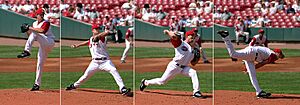Work (physics) facts for kids
In physics, work happens when a force makes something move. It's not just any movement; the object has to move in the same direction as the force pushing or pulling it.
For example, when a baseball pitcher throws a ball, they do work on the ball by making it move forward. If you push a box across the floor, you are doing work on the box. But if you push a wall and it doesn't move, you haven't done any work in physics, even if you feel tired!
Work is a way to measure how much energy is transferred when a force causes movement. It's measured in units called joules. The idea of "work" in physics was first used in the 1830s by a French mathematician named Gaspard-Gustave de Coriolis.
How Work and Energy Are Connected
Work and energy are closely related. When work is done on an object, its kinetic energy (the energy of motion) changes.
Think of a skateboarder:
- If you push a skateboarder to make them go faster, you do positive work on them, and their kinetic energy increases.
- If the skateboarder slows down because of friction (a force pushing against their movement), friction does negative work, and their kinetic energy decreases.
This connection is called the work-energy theorem. It means that the amount of work done on an object equals the change in its kinetic energy.
Calculating Work
Calculating work is simple if the force and movement are in the same direction.
If a steady force pushes an object a certain distance, and the force and movement are parallel, you can find the work done by multiplying the force by the distance.
For example, if you push a toy car with a force of 10 newtons for 2 meters, the work done is 10 newtons multiplied by 2 meters, which equals 20 joules.
- If the force and the movement are in the same direction, the work is positive. This means energy is being added to the object.
- If the force and the movement are in opposite directions, the work is negative. This means energy is being taken away from the object.
An example of negative work is when you lift a heavy book. Your muscles do positive work to lift it up, but the force of weight (gravity) is pulling the book down. Since the book is moving up and gravity is pulling down, gravity is doing negative work on the book.
Images for kids
See also
 In Spanish: Trabajo (física) para niños
In Spanish: Trabajo (física) para niños



